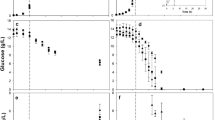Abstract
This work reports the cloning, expression, and purification of a 42-kDa fragment of the SpaA protein from Erysipelothrix rhusiopathiae, the main antigenic candidate for a subunit vaccine against swine erysipelas. The use of an auto-induction protocol to improve heterologous protein expression in recombinant Escherichia coli cultures was also investigated. The cellular growth pattern and metabolite formation were evaluated under different induction conditions. The His-tagged protein was over-expressed as inclusion bodies, and was purified by a single chromatography step under denaturing conditions. Auto-induction conditions were shown to be an excellent process strategy, leading to a high level of rSpaA expression (about 25 % of total cellular protein content) in a short period of time.






Similar content being viewed by others
References
Makino SI, Okada Y, Maruyama T et al (1994) Direct and rapid detection of Erysipelothrix rhusiopathiae DNA in animals by PCR. J Clin Microbiol 32:1526–1531
Freeman MJ (1964) Effects of vaccination on the development of arthritis in swine with erysipelas: clinical, hematological, and gross pathological observations. Am J Vet Res 27:597–606
Wood RL (1992) Erysipelas. In: Leman AD et al (eds) Disease of swine. Iowa State University Press, Iowa, pp 475–486
Imada Y, Goji N, Ishiwaka H et al (1999) Truncated surface protective antigen (SpaA) of Erysipelothrix rhusiopathiae serotype 1a elicits protection against challenge with serotypes 1a and 2b in pigs. Infect Immun 67:4376–4382
Shimoji Y, Mori Y, Fischetti VA (1999) Immunological characterization of a protective antigen of Erysipelothrix rhusiopathiae: identification of the region responsible for protective immunity. Infect Immun 67:1646–1651
Yamazaki Y, Sato H, Sakakura H et al (1999) Protective activity of the purified protein antigen of Erysipelothrix rhusiopathiae in pigs. J Vet Med B 46:47–55
Shimoji Y, Ogawa Y, Osaki M et al (2003) Adhesive surface proteins of Erysipelothrix rhusiopathiae bind to polystyrene, fibronectin, and type I and IV collagens. J Bacteriol 185:2739–2748
To H, Someno S, Nagai S et al (2010) Immunization with truncated recombinant protein SpaC of Erysipelothrix rhusiopathiae strain 715 serovar 18 confers protective immunity against challenge with various serovars. Clin Vaccine Immunol 17:1991–1997
Studier FW (2005) Protein production by auto-induction in high-density shaking culture. Protein Expr Purif 41:207–234
Silva AJ, Baptista-Neto A, Cilento MC et al (2008) Bioreactor aeration conditions modulate growth and antigen expression during Erysipelothrix rhusiopathiae cultivation. Appl Microbiol Biotechnol 79:23–31
Sanger F, Nicklen S, Coulson AR (1977) DNA sequencing with chain-terminating inhibitors. Proc Natl Acad Sci 74:5463–5467
Sambrook J, Russel DW (2001) Molecular cloning: a laboratory manual, 3rd edn. Cold Spring Harbor Laboratory Press, New York
Simpson RJ (2003) Proteins and proteomics: a laboratory manual. Cold Spring Harbor Laboratory Press, New York, pp 119–123
Laemmli UK (1970) Cleavage of structural proteins during the assembly of the head of bacteriophage T4. Nature 227:680–685
Pepinsky RB (1991) Selective precipitation of proteins from guanidine hydrochloride-containing solutions with ethanol. Anal Biochem 195:177–181
Abramoff MD, Magalhaes PJ, Ram SJ (2004) Image processing with ImageJ. Biophotonics Int 11:36–42
Acknowledgments
The authors gratefully acknowledge financial support from Fundação de Amparo à Pesquisa do Estado de São Paulo (FAPESP) and Conselho Nacional de Desenvolvimento Científico e Tecnológico (CNPq). We thank Amadeus Azevedo for technical assistance and Dr. Heloísa S. Selistre de Araújo for helping during antibody preparation. We also thank Fernando F. P. de Paula and Dr. Flávio H. Silva for sequencing the recombinant plasmids used in this work.
Author information
Authors and Affiliations
Corresponding author
Rights and permissions
About this article
Cite this article
da Silva, A.J., da Costa Iemma, M.R., Luperni Horta, A.C. et al. Cloning, Auto-induction Expression, and Purification of rSpaA Swine Erysipelas Antigen. Curr Microbiol 65, 369–374 (2012). https://doi.org/10.1007/s00284-012-0171-y
Received:
Accepted:
Published:
Issue Date:
DOI: https://doi.org/10.1007/s00284-012-0171-y




